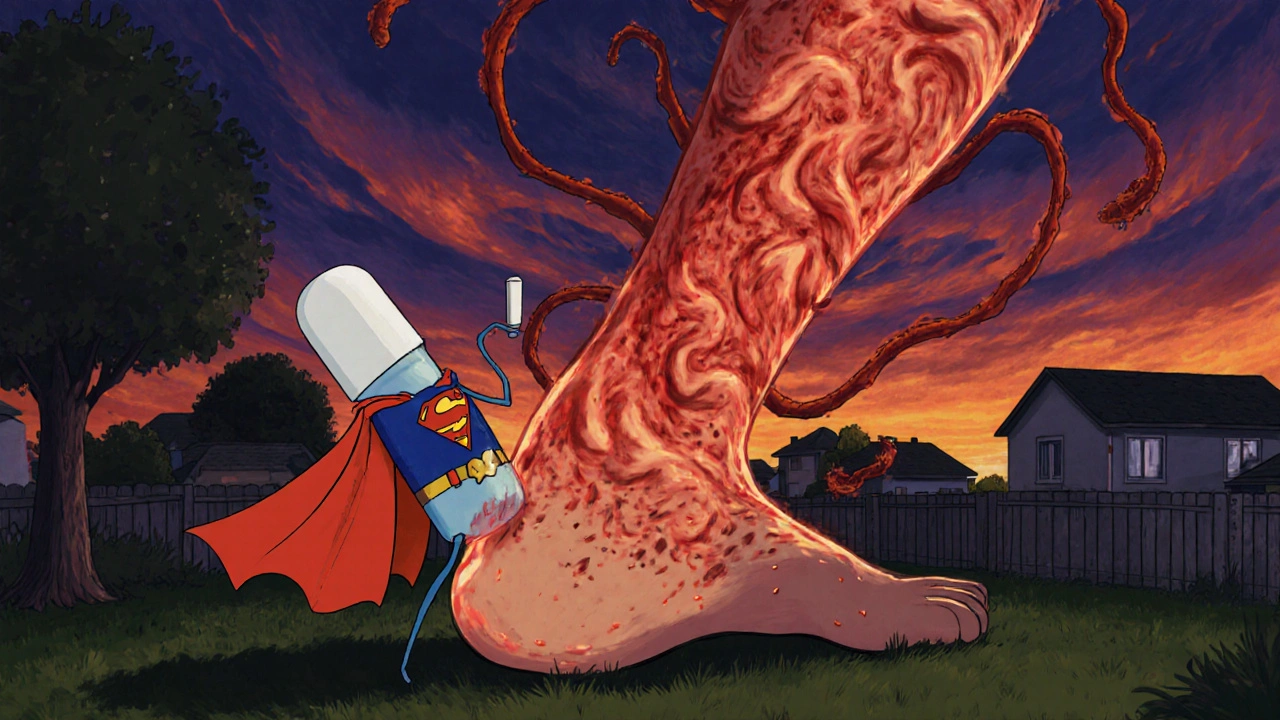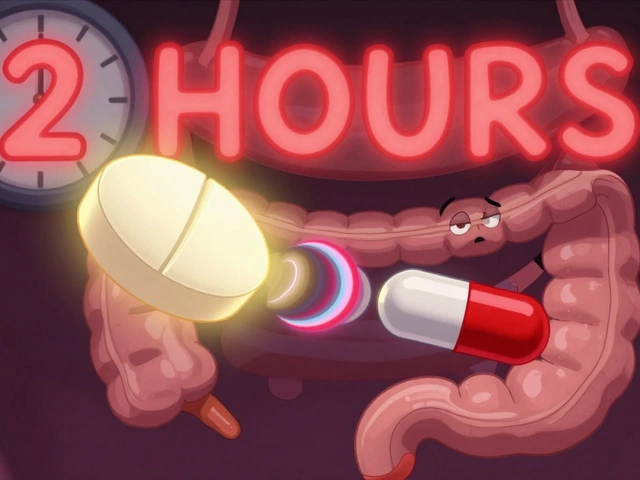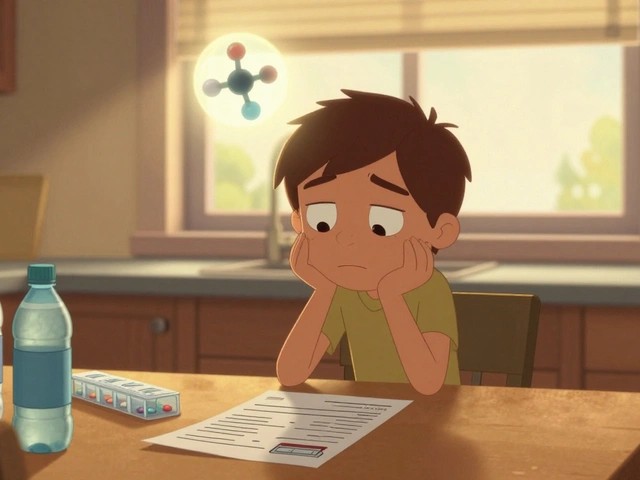Every year, millions of people worldwide deal with bacterial skin infections - and most of them aren’t serious. But knowing the difference between a simple rash and something that needs urgent care can make all the difference. Two of the most common types you’ll hear about are impetigo and cellulitis. They look similar at first glance, but they’re not the same. One is a surface-level nuisance; the other can turn dangerous fast. And the antibiotics you use? They’re not interchangeable.
What Is Impetigo - And Why Is It So Common in Kids?
Impetigo is the go-to diagnosis when a child comes in with red sores around the nose or mouth that turn into honey-colored crusts. It’s contagious, it’s messy, and it’s everywhere in daycare centers and schools. In fact, the World Health Organization estimates 162 million children globally get it each year, especially in warm, humid climates.
There are two main types: nonbullous and bullous. Nonbullous is the most common - about 70% of cases. It starts as tiny red bumps or blisters that quickly break open, ooze, and form that thick, sticky crust. Bullous impetigo, mostly seen in babies under two, shows up as larger fluid-filled blisters that burst easily, leaving raw patches with a ring of leftover blister skin around them.
What causes it? For years, doctors thought Group A Strep was the main culprit. But today, it’s mostly Staphylococcus aureus - and nearly all of these strains make a special enzyme called penicillinase that breaks down penicillin. That’s why penicillin doesn’t work anymore. In fact, about 68% of impetigo cases won’t respond to it. That’s a big reason why doctors now avoid prescribing penicillin for skin infections.
Most cases are mild and stay on the surface. But in 5% of cases, it can turn into ecthyma - a deeper infection that forms painful ulcers and leaves scars. And in rare cases, especially in young children, it can trigger something called staphylococcal scalded skin syndrome (SSSS), where the skin peels off like a burn. That’s a medical emergency.
Cellulitis: When the Infection Goes Deeper
Cellulitis is not the same as impetigo. It doesn’t just sit on top of the skin. It burrows into the deeper layers - the dermis and fat underneath. That’s why it feels hot, swollen, and tender to the touch. The edges aren’t sharp; they blur into normal skin. It often shows up on the lower legs, especially in adults over 65.
It doesn’t spread from person to person. It starts when bacteria sneak in through a crack - a bug bite, a cut, a fungal infection like athlete’s foot, or even a dry, cracked patch of skin. About 65% of cases come from minor injuries you might not even notice.
The bacteria? Mostly Streptococcus pyogenes - the same one linked to strep throat. But Staphylococcus aureus is also common, especially in people with diabetes or who’ve had surgery. And here’s the scary part: 5-9% of cellulitis cases lead to bacteria entering the bloodstream. That’s bacteremia. In 0.3% of cases, it becomes necrotizing fasciitis - the flesh-eating infection you hear about in the news.
Diagnosing it isn’t always easy. Doctors have to rule out other things like blood clots, swollen lymph nodes, or chronic skin conditions. No lab test is perfect. Usually, they go by how it looks, how fast it’s spreading, and whether you have a fever.
Antibiotics: Why One Size Doesn’t Fit All
Impetigo and cellulitis need totally different treatments - and not just because one is deeper than the other. The bacteria involved respond differently to drugs.
For mild, localized impetigo, the first-line treatment is topical mupirocin (Bactroban). You apply it three times a day for five days after gently washing off the crusts with warm soapy water. Studies show it works in 85-95% of cases. Kids become non-contagious within 24 hours of starting it. That’s why schools and daycares require kids to wait 24 hours after antibiotics before returning.
But if the infection is widespread, or if it’s the bullous type, you need oral antibiotics. Cephalexin is the usual pick - 25-50 mg per kg of body weight, split into doses over seven days. It covers both staph and strep.
Cellulitis? You need systemic antibiotics - pills or IV. For mild cases, oral cephalexin or dicloxacillin (500 mg four times a day) for 5-14 days is standard. But here’s the twist: in the U.S., half of all community staph infections are now methicillin-resistant (CA-MRSA). That means cephalexin might not cut it.
That’s why the Infectious Diseases Society of America now recommends doxycycline or trimethoprim-sulfamethoxazole as first-line for suspected MRSA. These work well against resistant strains and have cure rates of 85-90%. If the infection is severe - fever, rapid spread, or you’re immunocompromised - you’ll need IV antibiotics like cefazolin in the hospital.
And yes, there’s a new option: retapamulin (Altabax), a topical antibiotic approved for impetigo. Recent trials show it’s 94% effective in kids. It’s not everywhere yet, but it’s gaining ground as an alternative to mupirocin, especially where resistance is rising.

What You Shouldn’t Do
Don’t try to pop the blisters. Don’t share towels, clothes, or bedding. Don’t wait to see if it “clears up on its own.” Impetigo might seem harmless, but it spreads fast. Cellulitis won’t get better without antibiotics - and delaying treatment increases the risk of serious complications.
Also, don’t assume antibiotics are always the answer. Many rashes look like infections but are fungal or allergic. A misdiagnosis can lead to unnecessary antibiotics, which fuels resistance. If you’re unsure, get it checked.
When to Worry - Signs of Trouble
For impetigo: If the sores keep spreading after 3 days of treatment, if your child has a fever, or if they seem unusually tired, call your doctor. If the skin starts peeling off in sheets - especially around the eyes or mouth - get emergency help. That’s SSSS.
For cellulitis: If the red area grows more than 2 cm in a day, if you develop a fever over 38.3°C (101°F), if you feel dizzy or nauseous, or if the skin turns purple or black - go to the ER. These are signs it’s getting into your blood or deeper tissues.
Prevention: Simple Steps That Work
Most bacterial skin infections start with a tiny break in the skin. So prevention is straightforward:
- Wash cuts and scrapes with soap and water right away.
- Keep nails short - especially in kids - to avoid scratching.
- Treat athlete’s foot quickly. Those cracks between toes are prime entry points.
- Avoid sharing towels, razors, or sports gear.
- In outbreak settings (like daycare), use antibacterial soap for daily washing.
- Don’t ignore eczema or psoriasis flare-ups. Keep skin moisturized and controlled.
And here’s something most people don’t realize: obesity, diabetes, and poor circulation all raise your risk of cellulitis. Managing those conditions isn’t just about heart health - it’s about skin health too.

Antibiotic Resistance Is Real - And Getting Worse
Over the last decade, resistance has climbed fast. In some areas, 45% of staph infections are MRSA. Up to 65% of staph strains are now resistant to erythromycin. That means older antibiotics are becoming useless.
That’s why doctors are being more careful. They’re not prescribing antibiotics for every red patch anymore. They’re waiting to see if it’s truly bacterial. New point-of-care tests are being developed that can identify the bug and its resistance profile in under 30 minutes. That could cut down on wrong prescriptions by 40%.
For now, the rule is simple: use the right antibiotic, for the right infection, for the right length of time. Don’t stop early just because it looks better. Don’t save leftover pills for next time. And never use someone else’s prescription.
What Happens After Treatment?
Impetigo usually heals without scarring - though you might see temporary light or dark patches where the sores were. These fade over weeks to months.
Cellulitis leaves no visible mark, but the risk of recurrence is high - especially if the root cause isn’t fixed. People with diabetes or leg swelling have up to a 30% chance of getting it again within a year. That’s why follow-up care matters.
And yes, there’s a small risk of kidney problems after strep-related impetigo - post-streptococcal glomerulonephritis. It’s rare (1-5% of cases), but it can happen weeks after the skin infection clears. Watch for swollen eyes, dark urine, or high blood pressure. If you notice any of those, get checked.
Is impetigo contagious?
Yes, impetigo is highly contagious. It spreads through direct skin contact or by touching things like towels, toys, or clothing that have been contaminated. Kids in daycare or school are most at risk. They stop being contagious 24 hours after starting the right antibiotic treatment, or once the sores are dry and crusted.
Can cellulitis spread from person to person?
No, cellulitis is not contagious. It happens when bacteria from your own skin - or from a cut - get into deeper layers. You can’t catch it from someone else. But if you have a cut and come into contact with someone who has impetigo, you could get the bacteria on your skin and later develop cellulitis if the bacteria enter through a break.
Why isn’t penicillin used anymore for impetigo?
Because nearly all staph bacteria that cause impetigo now produce an enzyme called penicillinase that breaks down penicillin. Studies show about 68% of cases won’t respond to penicillin. That’s why doctors now use mupirocin, cephalexin, or other antibiotics that still work against these resistant strains.
How long does it take for antibiotics to work on cellulitis?
You should start seeing improvement in 48 to 72 hours. Redness should stop spreading, swelling should go down, and pain should lessen. If you don’t feel better by then - or if you get worse - you need to go back to your doctor. You might need a stronger antibiotic or IV treatment.
Can I use over-the-counter creams for impetigo?
No. Over-the-counter antibacterial creams like Neosporin won’t work well for impetigo. The bacteria involved are resistant to many common ingredients. You need a prescription antibiotic like mupirocin or retapamulin. Using the wrong cream can delay healing and make the infection worse.
Is it safe to use antibiotics for mild skin infections?
Only if it’s truly bacterial. Many rashes look like infections but are caused by fungi, allergies, or viruses. Taking antibiotics unnecessarily contributes to drug resistance. Always get a proper diagnosis. For mild impetigo, topical antibiotics are preferred over pills to reduce overall exposure.
What’s the difference between impetigo and eczema?
Eczema is a chronic inflammatory condition that causes dry, itchy, flaky skin. It doesn’t have honey-colored crusts or pus-filled blisters. But if eczema skin gets broken and infected, it can develop into impetigo. That’s why keeping eczema under control is key - it reduces the chance of bacterial invasion.
Can adults get impetigo?
Yes, but it’s much less common. Adults usually get it if they have a weakened immune system, diabetes, or close contact with infected children. It can also appear in athletes who share equipment or in people living in crowded conditions. The treatment is the same as for kids.
What Comes Next?
If you’ve had impetigo or cellulitis once, you’re at higher risk for another. That’s why prevention and follow-up matter. Keep your skin healthy. Treat cuts right away. Watch for signs of recurrence. And if you’re unsure - don’t guess. See a doctor.
The future of treating these infections is moving toward faster, smarter tools - tests that tell you exactly what’s causing the problem and which antibiotic will work. Until then, the best defense is knowing the difference between a harmless rash and something that needs real attention.







Man, I wish I’d known all this when my niece got impetigo last year. We thought it was just a rash and let it go for days. Turns out she was contagious as hell and spread it to her brother. Mupirocin saved the day though - 24 hours later she was back at school. Just don’t ignore those crusty sores, folks.
Let’s be real - this article reads like a pharmaceutical brochure. Everyone knows antibiotics are overprescribed. The real issue isn’t resistance - it’s that doctors are scared of being sued if they don’t write a script. Skin infections? Let your immune system do its job. Most rashes clear up in a week without drugs.
Cellulitis is just a fancy word for infection and yeah it can be bad but like most things if you don’t panic and just keep it clean it’s fine also why is everyone so scared of staph like it’s some kind of zombie virus
Oh so now we’re supposed to trust the IDSA? The same group that told us hydroxychloroquine was useless for COVID and then turned out they were funded by Big Pharma? Don’t fall for the ‘evidence-based’ nonsense. MRSA isn’t some mysterious superbug - it’s the result of people taking antibiotics like candy. And don’t get me started on mupirocin - that stuff’s barely better than Vaseline with a patent.
Interesting how this article ignores the fact that 80% of these infections happen in low-income neighborhoods with zero access to dermatologists. We’re blaming patients for not washing their cuts while the real problem is systemic neglect. You think a single mom working two jobs has time to buy prescription creams? This is healthcare colonialism dressed up as education.
As a global health educator, I find this piece exceptionally well-researched and balanced. The distinction between impetigo and cellulitis is critical in primary care settings across resource-limited regions. The emphasis on prevention - particularly wound hygiene and dermatological comorbidity management - aligns with WHO’s 2023 skin infection guidelines. Thank you for highlighting the socioeconomic dimensions of bacterial colonization.
skin is our first mind 🌱
we forget it's alive
it breathes
it feels
it cries when we ignore it
impetigo? it's not a bug
it's a message
your body is screaming for care
not just antibiotics
listen to it
wash gently
rest
feed it with love
not just mupirocin 😊
It’s fascinating how the microbiome-host interface modulates pathogenic virulence expression in cutaneous biofilms. The penicillinase-mediated hydrolysis of beta-lactam rings represents a classic case of horizontal gene transfer-driven phenotypic adaptation - particularly in S. aureus MRSA lineages with SCCmec type IV. The therapeutic imperative, therefore, necessitates a shift from empirical to precision antimicrobial stewardship, leveraging rapid molecular diagnostics to mitigate collateral damage to commensal flora.
Look, I’ve read the WHO reports, the IDSA guidelines, and even the Cochrane reviews - and I’m sorry, but this article feels like it was written by a medical student who just finished their dermatology rotation. Retapamulin? Really? It’s not even FDA-approved for all age groups. And you act like cephalexin is some magic bullet - but resistance rates in the Midwest are already hitting 30%. This is surface-level knowledge wrapped in jargon. You’re not informing - you’re performative.
Just curious - does the 5% of impetigo cases that progress to ecthyma correlate with any particular demographic or hygiene factor? Or is it purely random? I’ve seen people with perfect hygiene get it, and others with dirty hands who never do. Is there a genetic component? Or is it just bad luck?
While the clinical distinctions between impetigo and cellulitis are accurately delineated, I must emphasize the critical importance of longitudinal follow-up in patients with recurrent cellulitis, particularly those with underlying venous insufficiency or lymphedema. The 30% recurrence rate cited is not merely a statistic - it represents a profound disruption in quality of life, often leading to chronic pain, mobility limitations, and psychological distress. Multidisciplinary care - including vascular evaluation, compression therapy, and patient education - is not optional; it is the cornerstone of sustainable dermatological health. Furthermore, the underreporting of post-streptococcal glomerulonephritis in adult populations remains a significant clinical blind spot that warrants further epidemiological investigation.
Just wanted to add - if you’ve had cellulitis before, ask your doctor about compression socks if you’re prone to leg swelling. It’s not glamorous, but it cuts recurrence risk in half. Also, treat athlete’s foot like it’s a bomb - because it’s basically a Trojan horse for bacteria. I used to ignore mine until I got cellulitis at 34. Never again.
bro this is why you don't trust doctors. they want you on antibiotics forever. i used honey on my kid's impetigo and it cleared in 2 days. no script needed. 🍯🔥